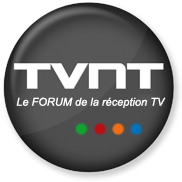Bonjour,
à ma connaissance le NTSC 4,43 MHz provient uniquement de la lecture que K7 VHS NTSC sur des appareils Européens.
En VHS PAL tout comme en VHS NTSC la chrominance est enregistrée en UNDER COLOR autour de 627 KHz.
J'ai des magnétoscopes VHS et SVHS qui ont le NTSC Playback et sur ces appareils il n'y a pas de commutateur NTSC 4,43/PAL 60 comme sur mon premier feu HITACHI.
Le VHS NTSC sort directement en PAL 60 HZ.
Notez que sur mes lecteurs Laserdisc PIONEER, il y a un petit bouton pour activer ou non le transcodage en PAL 60 HZ sur les vidéodisques NTSC. Mon ancienne SONY Trinitron acceptait le NTSC 3,58 donc pas besoin.
NTSC — pal — secam
Re: NTSC — pal — secam
DVB-T (TNT) Chambéry 1 Dent du Chat.
DAB+ 12A La Dôle.
DAB+ 12A La Dôle.
- jeanphi73
- Hippo

- Messages: 4120
- Inscription: 27 Juin 2005 23:07
- Localisation: Rhône-Alpes
Re: NTSC — pal — secam
Bonjour,
pour les nostalgiques du PAL/SECAM/NTSC il y a un projet intéressant basé sur le décodage logiciel de ces formats de couleur analogique, LD-decode :
https://github.com/happycube/ld-decode/wiki
C'est un projet qui consiste à récupérer le signal brut pal vidéo-composite d'un laserdisc, via une carte électronique, le domesday duplicator :
le signal RF (converti en fichier binaire) est décodé ensuite sur PC via l'utilitaire cvbs-decode pour retrouver la couleur,
la même logique a été ensuite reprise pour les cassettes VHS, avec vhs-decode :
https://github.com/oyvindln/vhs-decode/ ... /README.md
l'outil cvbs-decode sait aussi décoder le PAL et le NTSC produit par le logiciel hacktv,
mais hélas l'outil cvbs-decode ne gère pas le SECAM :
Je serai bien tenté de combler ce manque, en développant un outil permettant de décoder la couleur SECAM, depuis des images noir et blanc contenant la chroma SECAM, on en parlait sur le sujet du 819 lignes :
les-819-lignes-revivent-t34481-10.html#p748840
La carte domesday duplicator est basée sur une carte de développement FPGA "DE0-nano" :
elle peut-être remplacée par une carte tuner TV contenant une puce "Conexant CX23880/1/2/3", en utilisant un pilote modifié (cxadc) on peut capturer le signal RF du lecteur laserdisc et la sortie RF du tambour de lecture d'un magnétoscope VHS :
le site du pilote modifié pour la puce Conexant CX2388x :
https://github.com/happycube/cxadc-linux3
pour les nostalgiques du PAL/SECAM/NTSC il y a un projet intéressant basé sur le décodage logiciel de ces formats de couleur analogique, LD-decode :
https://github.com/happycube/ld-decode/wiki
C'est un projet qui consiste à récupérer le signal brut pal vidéo-composite d'un laserdisc, via une carte électronique, le domesday duplicator :
le signal RF (converti en fichier binaire) est décodé ensuite sur PC via l'utilitaire cvbs-decode pour retrouver la couleur,
la même logique a été ensuite reprise pour les cassettes VHS, avec vhs-decode :
https://github.com/oyvindln/vhs-decode/ ... /README.md
l'outil cvbs-decode sait aussi décoder le PAL et le NTSC produit par le logiciel hacktv,
mais hélas l'outil cvbs-decode ne gère pas le SECAM :
The repository also contains an experimental CVBS decoder, cvbs-decode, which shares code with ld-decode and vhs-decode. Capable of decoding basic raw digitized NTSC and PAL composite video, including color if the source is somwhat stable. Samples can be captured using cxadc, however this is somewhat buggy as the cx chip can decide resample or do other things if it detects a valid video signal. Test samples can also be generated using HackTV.
Je serai bien tenté de combler ce manque, en développant un outil permettant de décoder la couleur SECAM, depuis des images noir et blanc contenant la chroma SECAM, on en parlait sur le sujet du 819 lignes :
les-819-lignes-revivent-t34481-10.html#p748840
La carte domesday duplicator est basée sur une carte de développement FPGA "DE0-nano" :
The domesday duplicator is a custom made solution, originally geared towards capturing RF from laserdiscs players, it does however also work well for digitizing VHS RF data. It consists of a custom analog to digital board, a DE0-NANO FPGA development board, and a Cypress SuperSpeed Explorer development board. More in-depth information about it can be found in the Domesday86 project wiki. A major downside of this approach is that the custom board requires prining the PCB and assembling the components yourself (unless you can find someone that have ready-made ones for sale.), and the cost can be a bit high.
elle peut-être remplacée par une carte tuner TV contenant une puce "Conexant CX23880/1/2/3", en utilisant un pilote modifié (cxadc) on peut capturer le signal RF du lecteur laserdisc et la sortie RF du tambour de lecture d'un magnétoscope VHS :
The budget approach is using a video capture card based on a Conexant CX23880/1/2/3 chipset. With a modded driver, these cards can be made to capture raw data instead of decoding video normally as they otherwise would. The original cards with this chipset were cards that plugged into the PCI slot (the chip is an all-in-one chip that handles both video decoding and pci interface.) However, there are also newly-made chinese variants that can be found on aliexpress and similar that are made to work in pci-express slots. An advandage of this approach is that the cards (both old PCI ones and new PCIE ones) can be very cheap. The cards may however be a bit more subject to noise compared to the domesday duplicator, though we have not done extensive testing on how they stack up. Capture is done using the custom cxadc driver (currently linux only). See the CXADC website/repository for more details.
le site du pilote modifié pour la puce Conexant CX2388x :
https://github.com/happycube/cxadc-linux3
-

Mannix54 - Etalon

- Messages: 1224
- Inscription: 18 Oct 2007 09:21

